
My first reaction, after disbelief, was anger. I assumed that the construction workers had come and dismantled my hide which had taken me so much time and effort, not to mention getting mud up to my knees, to build. Had they objected to my taking their 'junk' plywood to make my hide? Why go to so much effort to ruin something that wasn't causing any obstruction to them? Why hadn't they told me to stop building it when they had seen me yesterday? Before long I was fairly fuming at the injustice of it all. I looked around and couldn't see where they had put my wood. I looked at the place where my hide had stood again. I couldn't see any footprints of the people who had taken away the hide. Come to think of it, I couldn't even see my own footprints that I had made yesterday when setting up the hide. Suddenly it dawned on me! My hide had been dismantled not by construction workers but by last night's high tide! I immediately had to repent of all the bitter thoughts I'd had toward the construction workers who, up till now, have shown nothing but politeness and interest in my activities. I also had to laugh! Point to remember when building a hide on the high water mark - nighttime high tides may be higher than daytime ones!
Once I had solved the mystery of the missing coffin, I settled down to scan the roost. The Sanderling was still present, and the number of Broad-billed Sandpipers had gone up to 10. There was also a lone Great Knot - the first I've seen this month. Little Tern numbers had increased dramatically, from 3 to over 30. Other than that it was business as usual, with numbers overall again slightly down on earlier in the week.

A couple of Terek Sandpipers on the mud. The stretching bird is still in primary moult - the outer two are still unmoulted, and it seems to have lost all its secondaries. It must be an adult bird as juveniles don't have a wing moult till their second winter.
A few birds have started to use the pools up on the red earth again, despite the more frequent human activity. There were 20 or so stints and a lone Curlew Sandpiper bathing in the rainwater pools, allowing me to get quite close in the car. The Kentish and Malaysian Plover flock was again present, with similar numbers of both to two days ago.

I like this picture because it shows well the 'typical' jizz of a Red-necked Stint - flat back, long slender body (reminiscent of Temminck's), square headshape, and straight-edged, slightly club-ended bill.
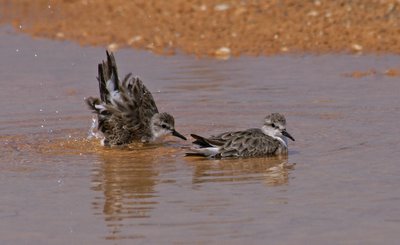
Man that looks good on a hot day like today! Hard to believe they aren't enjoying this!
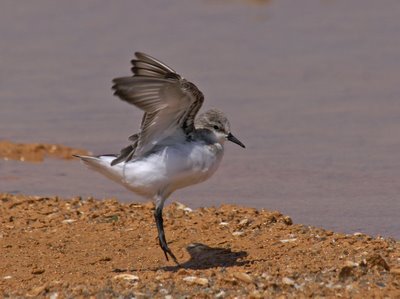
After the wash, the spin dry - or rather - the flap dry!
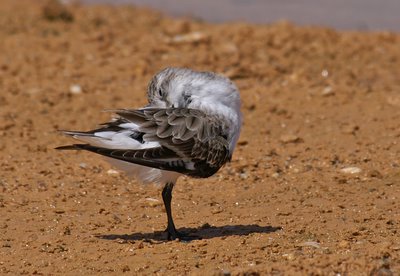
Another bird gets stuck into the serious business of keeping the feathers in tip-top condition. It surprises me how long birds will take over the business of preening when uninterrupted. They really do a thorough job.I guess it's not so surprising when you think that they spend all day in the mud! There's not a speck of dirt on this bird though.

A different bird and a different angle. It's not often you get a good view of a stint's tail, but here's one!
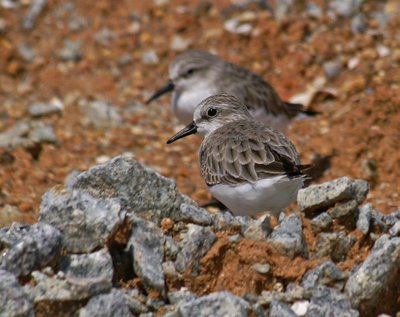
All spruced up and ready for the next foray to the muddy tide-line!

This unfortunate individual had a missing foot. It compensated by holding its whole leg lower - hence the disparity between the height of the tibio-tarsal joint of each leg.
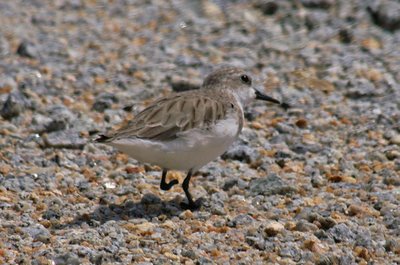
Maimed waders like this aren't that uncommon (I photographed a crippled Pacific Golden Plover earlier in the autumn). One wonders what the cause could be - a birth defect? a misfiring trap? a predatory fish? Gulls seem to have an even higher incidence of lameness, which suggests to me that the cause is related to proximity to humans.

A lone Curlew Sandpiper looked huge among the stints.
I find myself wondering how easy it would be to pick out a lone Dunlin among the roosting Curlew Sandpipers at this time of year. It's probably not that difficult, but still... Dunlin are the commonest small calidrid in my native UK but a great rarity here.
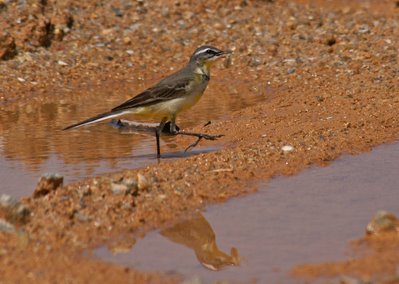
This male simillima race Yellow Wagtail has caught some prey - I think it's a dragonfly larva.
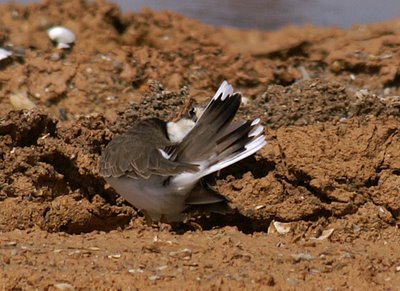
More preening antics - this time it's a Little Ringed Plover that's spending plenty of time 'in the bathroom'! This is a valuable shot of the tail pattern - which is one of the best distinguishing features from Long-billed Plover in this plumage. The latter lacks the white tail sides.

Each filament of a feather is locked onto the adjoining ones by a series of fine barbs or hooks (a bit like Velcro). In the hustle of feeding and flying, these can become unhooked, which inhibits the feather's efficiency. By passing each feather through the bill during preening, the bird can 'zip up' the filaments to each other again, ensuring that they stay in perfect condition. This Little Ringed Plover repeatedly zipped each tertial through its bill.
No comments:
Post a Comment